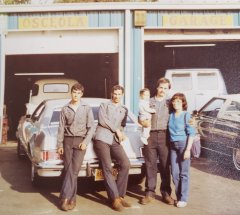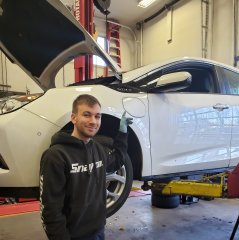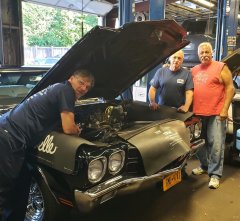-
Posts
4,902 -
Joined
-
Last visited
-
Days Won
456
Content Type
Forums
AutoShopOwner Articles
Downloads
Blogs
Gallery
Profiles
Events
Store
Links Directory
Shop Labor Rates
Community Map
Everything posted by Joe Marconi
-
In my 41-year career as a shop owner, I think that at least 80% of that time I experienced what I called, the Unexpected Wake-Up Call at 2:00 am. I would go over and over all the things that happened throughout the day, and what I needed to do tomorrow. For me, it was the uncertainty of the next day, and what fire I would need to put out that troubled me the most. I know you have those nights too, so let's share a little. What Keeps You Up at Night?
-
I see more and more, in every industry, employers offering sign-on bonuses to incentivize candidates. While I get the reasons why I think you need to be careful when offering a sign-on bonus. One thing to consider: What will your existing employees think? Especially those that are loyal and have been with you a long time. Another thing to think about; If the person you are hiring is basing his/her decision on money alone, is that good for the long term? I always struggled with sign-on bonuses, but I would like to hear from those that have done it, and how they handled it.
-

Nine Ways to Improve Your Bottom Line
Joe Marconi commented on Joe Marconi's blog entry in Joe's Blog
Surrounding yourself with the best people is something that is critical to all businesses. And there are many shop owners that have a difficult time getting the right people. However, it's the first step to success for any organization. After that, it's the leadership of the company. Too many leaders Demotivate their employees. But that's a topic for another post! Thanks Larry, for your comments! -
The strategies outlined in this blog reflect real-world strategies I have learned and used in my 41 years as an auto shop owner. I also use these strategies when helping clients as a business development coach. While running a successful auto repair shop today has many components, the list below contains the top 9 strategies I believe every auto shop owner should consider when looking for ways to improve their bottom-line profit. Ten Ways to Improve Your Bottom Line: Hire the best people and have enough staff. You will have a much easier time achieving success when you’re surrounded by the right people. Calculate your correct labor rate and adjust that labor rate every quarter. Charge a higher labor rate for jobs that do not include any parts, such as electrical testing, check engine lights, onboard computer issues, and drivability problems. The missing part profit must be made up somewhere. Review and refine your checklists and procedures to improve overall efficiency. Make sure all your equipment is working correctly and that you have the equipment and tools needed for the vehicles you service and repair. Make sure your part margins allow for a respectable gross profit. Make sure your inventory is up to date, with up-to-date pricing, and you don’t have too much stock sitting on the shelf. Make sure you have a process to get the proper credit for part cores, returned parts, and defective parts. Invest in ongoing training for all employees. BONUS TIP: Speak to your accountant and business coach about tax planning strategies. But do not wait until tax season. Tax planning should be done throughout the year. I hope you found this information helpful.
-

What are the Best Trade Shows to Attend?
Joe Marconi replied to Joe Marconi's topic in Events & Trade Shows
As an auto shop business owner, it's crucial that management/business training is the primary concern. Technicians need technical training; Service advisors need sales training and auto shop owners need business management training. I learned this being part of Elite Worldwide as a client, many years back. And it's why now, that I have sold my company, I still involve myself with them. -

What are the Best Trade Shows to Attend?
Joe Marconi replied to Joe Marconi's topic in Events & Trade Shows
I will name a few that I think are worthwhile attending, but there are many. Vision APEX/SEMA Super Saturday, Mid Atlantic Auto Care Alliance Fly with the Eagles- Elite Worldwide NAPA Summit ASTE- Automotive Service & Technology Expo Ratchet + Wrench conference -
The Mid-Atlantic Auto Care Alliance (MAACA) is again proud to host the 2022 Super Saturday event, which will be held in November at the Radisson Hotel Philadelphia Northeast! Registration for 2022 Super Saturday is OPEN! Hey ACA members…take advantage of MAACS’s special Savings that they are sharing with all ACA members, including MWACA, NWACA, TXACA, and FLACA members. Register for $259.00 for Friday and Saturday training. Hurry! Offer will end soon! Enter the following promo code when you check out: ACA. Register now! Topic 2: Legislation Updates
-
I can't argue with curb appeal. While you can't judge a book by its cover, the consumer likes to look at something appealing before they consider it.
- 3 replies
-
- 1
-

-
- markerting
- marketing budgets
- (and 4 more)
-
Super Saturday Sessions Flyer PROOF 6.PDF
-
Before you spend a dime on any advertising or marketing, you need to realize that it's the employee experience that will determine how effective your overall marketing plan is. Everyone in your repair shop and everything you do on a day-to-day basis is the foundation of your marketing plan. We have all heard, "Happy employees create happy customers." This is more important today than ever before. Remember this: Your advertising and marketing programs do one thing; it brings you, people. It's your job to make the sale, and more importantly, create a customer experience so amazing it gives your customers a compelling reason to return!
- 3 replies
-
- 1
-

-
- markerting
- marketing budgets
- (and 4 more)
-

Why Not Give a Tech a Pay Guarantee?
Joe Marconi replied to Joe Marconi's topic in Human Resources, Employees
There are infinite ways to set up a pay structure for techs, and for all employees. It would be hard to pinpoint what's best for a particular shop. When I owned my auto repair company, I found that paying people a very competitive base wage, with the opportunity to earn more through increased production (for techs), and having sales goals and gross profit goals for service advisors and managers. I also believe in team bonuses. With that said, I did also track comebacks and customer service scores (online reviews). You can't make the objective of more sold hours and sales, without considering the quality of your repairs and service, and also the customer experience. I was not a fan of a pure flat-rate plan, but there are shops where this is an effective pay program, with the right culture. Please note: Every pay plan should be received by a labor law attorney or human resource company. -

electric-vehicle-repair-somers-new-york.jpg
Joe Marconi posted a gallery image in Automotive Shop Photos
-

Classic-car-engine-repair-somers-new-york.jpg
Joe Marconi posted a gallery image in Automotive Shop Photos
-

Why Not Give a Tech a Pay Guarantee?
Joe Marconi replied to Joe Marconi's topic in Human Resources, Employees
A great strategy, based on culture! Would you say that the technicians consistently produced the hours that were needed to maintain sales and profits? -

New fuel mix from out of Australia
Joe Marconi replied to Eric Roberts's topic in General Automotive Discussion
Excellent post, and while disturbing, it is nice to see that we in US are not alone with the issues of fossil fuels and EVs. This new research in Australia is interesting and hopeful. My fear is that the that the same force that is looking to end fossil fuels will block this new technology. Again, great post! -
TACKLING TESLA MISCONCEPTIONS SOURCE: Motor.com Posted on October 20, 2022 An independent shop owner reviews the experiences that he and other professionals have had servicing vehicles made by the world’s largest EV manufacturer. This first of a two-part article discusses seven misconceptions By Jay Huh Today, it is hard to ignore the popularity and the exponential growth of electric cars, specifically Tesla. In 2019, Tesla delivered 367,200 cars globally. In 2021, they delivered 935,000 cars; that’s an increase of over 250% in only two years. In Q3 of 2022 alone, Tesla produced 365,000 cars… just shy of entire 2019 sales. What spurred this massive growth in EVs? Is this trend here to stay? Many automotive professionals and independent shop owners including myself are soon to be at a crossroads where we need to decide whether to pursue investing in electric vehicles or ignore them. This year we saw a massive spike in gas prices, over $120/barrel oil that sent gas prices soaring to over $6/gallon in some parts of the country. Undoubtedly, this pushed some consumers to find solutions for a cheaper fuel source. In May of last year, we also experienced a price surge when the Colonial Pipeline was shut down. It was that week where I decided to buy a Tesla. The result? In 15 months, my wife and I have logged a total of 60,000 miles in a Tesla Model S, Model Y and a Model 3. I can confidently say there are many misconceptions floating around about EVs. For the first installment of this two-part article, I interviewed two shop owners and a master certified Tesla trainer and share their experiences surrounding seven common misconceptions. Misconception #1: Teslas are difficult to work on file:///C:/Users/joe/AppData/Local/Temp/msohtmlclip1/01/clip_image002.jpgAaron Jones, Tesla Master Technician, automotive trainer for OPUS IVS and WORLDPAC Training Institute, says, “Teslas are very component-based and the OEM does its best to make a ‘plug and play’ software to diagnose everything that is wrong with this vehicle, so it’s not a lucrative business deal.” file:///C:/Users/joe/AppData/Local/Temp/msohtmlclip1/01/clip_image003.jpgSeth Thorson of Eurotech Auto Service (four locations based in Minnesota, $6 million/yr revenue) says: “Tesla is a technology company first, car manufacturer second. The car in itself is the scan tool.” In the automotive industry, diagnosing the fault correctly is often found to be the most difficult task in a repair. According to Jones and Thorson, Tesla is reversing this trend with software and, with the most difficult part of repair taken out of the equation, it should in essence make working on Teslas much easier. Almost all of Tesla fixes for recalls are done through over-the-air updates, says Thorson. When asked about the learning curve in working on Teslas, Jones states: “I think the learning curve is taken away as soon as they try.” Misconception #2: Easily electrocuted Bernard Tripp of Autohaus Lake Norman in North Carolina says: “a common reaction I see is how people act like they will be electrocuted if they remove a tire or a trim panel. First off, the car has both high voltage (400V) and low voltage (12V) systems, most of which are low voltage. This means the infotainment, windows and locks, seats, lights, etc., are all low voltage and can almost be treated like any other vehicle. The parts that are “high voltage” have safeguards in place to prevent accidental contact while live. I don’t think people realize that outside of the HV system, it is still just a car and has basic car functionality and needs (tires, filters, fluids, brakes, wipers, etc.).” Misconception #3: No parts and service info availability The biggest misconception surrounding Tesla repair according to Thorson is that there is no parts and/or service info available. Tesla released all service and repair information and it is currently free. You can sign up for it on Tesla’s website and it includes everything from service manuals to parts manuals, body repair, tooling, wiring diagrams, service bulletins, labor codes and labor guides. Tesla charges $500/mo or $3000/yr for their diagnostic software. Note, however, that the service information is only available directly from Tesla; you won’t find it in any of the third-party information products. As for parts, as a shop owner you can also sign up online to buy parts from Tesla. Thorson warns that one should be careful as they don’t follow the same rules as other manufacturers. If you receive a defective part, make sure to follow the correct procedures for the return. Do not just order another part hoping to get a return, because you won’t. Thorson learned this lesson the hard way as he has a new defective steering rack that is not returnable. Misconception #4: There are different ways to communicate with Tesla Service If you are trying to call or contact someone at Tesla service to make an appointment, inquire, or get a status update on your car, good luck. There is no phone number and there is no way to contact someone by phone. Everything is done on the app and you can only send messages through the app. You book your appointment on the app. When you drop off your car at Tesla service, no one is there to greet you. You park your car and they will give you Uber credits while your car is in service. You never see or meet your advisor unless you go out of your way to do so. This is an area where an independent shop can really shine. There will be customers that prefer human interaction with better and faster service. In my personal experience, my appointment with Tesla service got pushed back four times, so it took two months to get my vehicle in but the actual work took half a day. Misconception #5: Teslas have no oil or other fluids Thorson recommends replacing oil in the drive units at 60,000-mile intervals. These units also have spin-on oil filters. The high voltage batteries and drive units produce a lot of heat, so Teslas require coolant as well; however, it is important to note that a Tesla cooling system is nothing like a gas car cooling system. Tesla’s system is low pressure; it is imperative that one not use a coolant pressure tester as the plastic coolant pipe will burst in the most inconvenient location; i.e., above the HV battery, warns Thorson. The specs of Tesla coolant is identical to BMW coolant and should be maintained as such. Even with regenerative braking, Tesla still uses DOT3 brake fluid and the hygroscopic characteristics stay the same and should be flushed out. Misconception #6: Nothing to fix on a Tesla This is probably a shop owner’s biggest fear with fewer components on EVs compared to ICE (internal combustion engine) vehicles. Tripp shares some common failures he has seen on Teslas. “Each model has its fair share of issues, like any other vehicle. For Models 3 and Y, it is upper control arms. For Models S and X, it is lower control arms. Early Model S and Model X batteries seem to be a weak point. Those that were replaced under warranty are already failing. I know of 2012 and 2013 models that have had two or three HV (high voltage) battery pack replacements. Cooling system failures start occurring after a certain age. For Model S, we replace lots of exterior door handles and we also do instrument cluster screens due to internal fluid leaking out. Due to the aggressive charging of the 12V battery, it is not uncommon for the 12V battery to need replacement in 2-4 years.” Thorson adds that it is not uncommon to see drive unit failures early on. He has seen many case leaks and has seen several with internal coolant leaks due to bad seals where Tesla would recommend replacing the complete drive unit. He has fixed many by replacing the seal itself, saving owners thousands of dollars. He also adds that a steering rack on the Model 3 is a Land Rover rack and is prone to failing. Jones specifically points out common axle shafts problems which contribute to stuttering when accelerating. Misconception #7: Tesla’s require little to no maintenance It’s true, you no longer need to perform 5,000-mile oil changes but that does not mean these cars require no maintenance. According to Jones, the tires on Teslas wear out much faster than ICE vehicles and along with that, regular alignments should be performed along with regular tire rotations. The design of Tesla’s HVAC is problematic for the smell of mold in the cabin due to moisture, so cabin filters must be replaced at a shorter interval compared to other vehicles. With regenerative braking, brakes on Teslas can last up to 130,000 miles or more but that brings other problems such as seized caliper slide pins. Both Thorson and Jones recommend taking apart the brakes and lubricate all components regularly. As stated earlier, EVs still have oil and spin on filters, coolant and brake fluid that needs to be replaced. On Models 3 and Y, there are instances where bolts in the front suspension loosen over time, so these need to be checked and retorqued regularly. Final Thoughts: By really diving in and taking a close look into the rapid change in the world of transportation today, we uncover fears and stereotypes that surround new technology. However, by objectively looking at the situation head on, we can see that there is a bright future ahead for independent shop owners and a light at the end of the tunnel for early adopter consumers in dire need of better service and options in fixing and maintaining their vehicles. Whether Tesla/EV continues long term or something new comes along, the automotive repair industry needs to continually strive to adapt and train to be relevant in an ever-changing environment.
-
I recently read an article that said that giving a technician a pay guarantee each week promotes complacency and leads to lower production. In other words, if they don't produce, they don't get paid. Really? While I do get the logic, I don't agree. I am not going to promote one pay plan against another, but for me, if I require a technician, or any employee to be at my company a certain amount of hours, then they will get paid for every hour they are there. Now, I do believe in performance-based bonuses; so if someone produces more, they need to be rewarded for that. What I have found is that business success and maintaining high production levels requires hiring the right employees, and having the right culture combined with the right leadership. Your thoughts and comments?
-
I agree with Craig (bantar) 100%. As a shop owner, we need to have a clear understanding of when charging for our time begins. It's ok to check someone's tire pressure or install a set of wiper blades that the customer purchased, but does know how to install them. But, if we need to spend time chasing down a problem, we need to get paid for that. As a Business Coach, I can tell you that the biggest labor loss for too many repair shops is lost revenue when a tech is inspecting, testing, or checking into a problem. That time must be tracked, and the customer has to pay for that time. Not to bring up another topic, but the labor rate for testing and inspecting should be higher than your regular rate. The reason? There are no parts involved when a tech is performing tests, checking, or working on complicated driveability problems. And that means no part profit. Perhaps this is a topic for another post?
-

Don’t think you need an Exit Plan? Think Again!
Joe Marconi commented on Joe Marconi's blog entry in Joe's Blog
Agree. You need the right team of advisors around you. And that can be difficult. -

Don’t think you need an Exit Plan? Think Again!
Joe Marconi commented on Joe Marconi's blog entry in Joe's Blog
Thank you, as always for your feedback and great comments. It's much appreciated. With regard to coaching, perhaps the most difficult part is when you see things, and give advice, and the client does not act. Experiences have been a great teacher for me, and for many. But it's like the old saying, "When the STUDENT is ready, the TEACHER appears."





